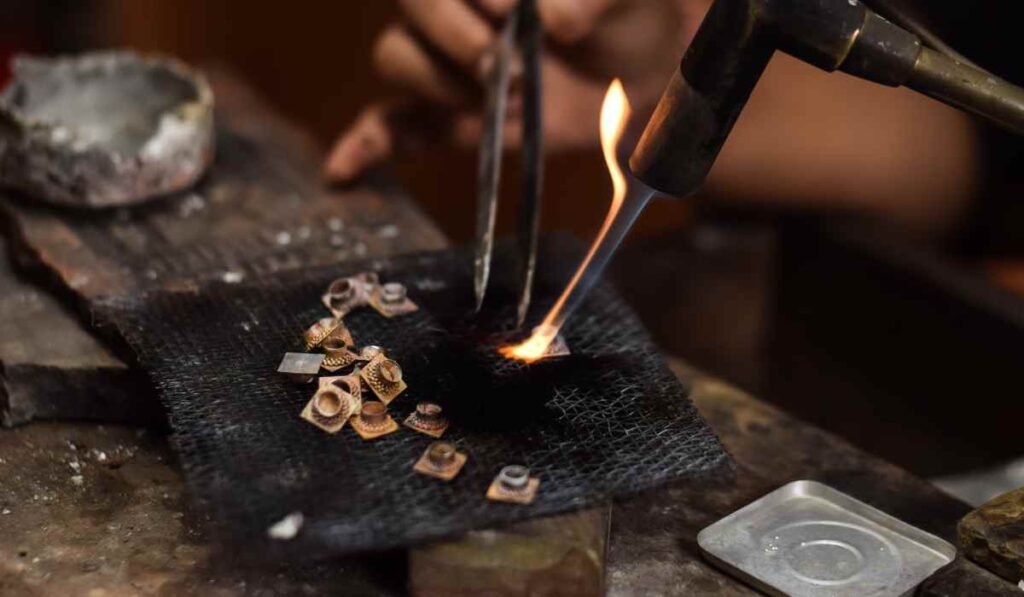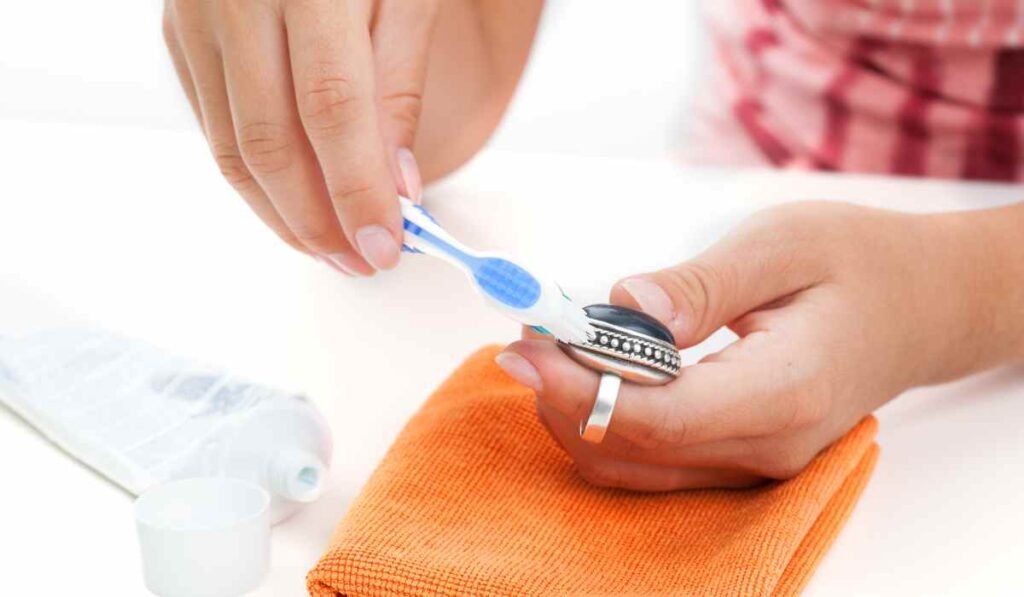Sterling silver and silver are often used interchangeably, but is there really no difference between them? In this article, we look into these precious metals, exploring their unique characteristics, applications, and the factors that set them apart.
Table of Contents
ToggleWhat is silver?
Silver is a metallic element with the chemical symbol Ag and atomic number 47, known for its brilliant white luster and exceptional conductivity. It is also knows as fine silver, found in the Earth’s crust, silver has been highly valued throughout history for diverse applications, including currency, jewelry, and industrial uses like electronics and photography.
Purity of Silver
The purity of silver is denoted by its fineness, indicating the amount of pure silver in an alloy. Fine silver, at 99.9% purity, is the purest form, but for practical purposes, silver is often alloyed for enhanced durability. Purity is marked on items, with “999” representing fine silver.

What is sterling silver?
Sterling silver is a high-quality alloy used in crafting jewelry, silverware, and decorative items. Comprising 92.5% pure silver and 7.5% other metals, typically copper, sterling silver achieves a balance, combining the brilliance of silver with enhanced durability.
The term “sterling” historically originated from 12th-century England, signifying the alloy’s reliability and strength. Recognized by a “925” stamp, sterling silver is renowned for its lustrous appearance and versatility in various forms of craftsmanship.
Purity of Sterling Silver
The purity of sterling silver is a crucial aspect defined by its composition. Marked with the stamp “925,” this alloy ensures that it contains 92.5% pure silver. The remaining 7.5% is primarily copper, reinforcing the metal to withstand the rigors of everyday use.
This combination not only contributes to sterling silver’s strength and durability but also addresses the susceptibility of pure silver to tarnishing. Widely cherished for its affordability and timeless elegance, sterling silver continues to be a preferred choice in the creation of elegant jewelry and exquisite silverware.
Differences between Silver & Sterling Silver
The primary distinctions between sterling silver and silver lie in their composition, durability, tarnish resistance, markings, cost, and uses. Let’s delve into the details of each aspect to understand the differences.
1. Composition
- Silver: When we refer to “silver” without any modifiers, we are usually talking about pure silver, also known as fine silver. Fine silver is composed of 99.9% silver.
- Sterling Silver: Sterling silver, on the other hand, is an alloy made up of 92.5% silver and 7.5% other metals, typically copper. The additional metals are added to improve the alloy’s strength and durability.
2. Durability
- Silver: Pure silver is relatively soft and malleable. While it has a brilliant luster, it is more prone to scratches, dents, and bending.
- Sterling Silver: The addition of copper to sterling silver increases its hardness and durability, making it more suitable for everyday use in jewelry, silverware, and other items.
3. Tarnish
- Silver: Pure silver is less prone to tarnishing compared to sterling silver.
- Sterling Silver: Sterling silver is more likely to tarnish over time due to its copper content. Tarnish appears as a darkening or discoloration on the surface but can be easily polished away to restore the metal’s shine.

4. Markings
- Silver: Fine silver may be marked with a “999” stamp to indicate its purity.
- Sterling Silver: Sterling silver is typically stamped with a “925” mark, denoting its 92.5% silver content.
5. Cost
- Silver: Fine silver is generally more expensive than sterling silver due to its higher purity.
- Sterling Silver: The addition of less expensive metals like copper makes sterling silver a more cost-effective option while retaining many of the desirable qualities of silver.
6. Common Uses
- Silver: Fine silver is often used in specialized applications such as certain coins, bullion, and specific industrial uses.
- Sterling Silver: Sterling silver is widely used in jewelry, silverware, and decorative items due to its combination of beauty, durability, and affordability.
Sterling Silver vs Silver: A Quick Comparison
| Criteria | Sterling Silver | Silver |
|---|---|---|
| Composition | 92.5% silver, 7.5% other metals | 99.9% pure silver |
| Tarnish Resistance | Higher | Lower |
| Common Use | Jewelry, utensils | Investment, bullion |
Maintenance Tips for Silver and Sterling Silver
To preserve the luster and quality of both silver and sterling silver items, it’s crucial to adopt proper maintenance practices. Here are some tips for caring for these precious metals:
General Tips for Silver and Sterling Silver
Regular Cleaning: Clean items regularly to prevent tarnishing. Use a mild silver polish or a mixture of baking soda and water for gentle cleaning. Avoid abrasive cleaners to prevent scratches.
Storage: Store silver and sterling silver in cool, dry places away from direct sunlight. Use anti-tarnish cloth or silica gel packets in storage areas to absorb moisture and prevent tarnish.
Avoid Exposure: Minimize exposure to chemicals, including household cleaners, perfumes, and lotions, as they can accelerate tarnishing. Remove silver jewelry during activities that expose it to harsh chemicals.
Gentle Handling: Handle items with clean hands to prevent oils and acids from the skin contributing to tarnishing. Minimize excessive touching.
Polishing Cloth: Keep a soft polishing cloth handy for regular buffing. This practice helps maintain the shine and prevents tarnish buildup.

Additional Tips for Sterling Silver
Moisture Management: Sterling silver can tarnish when exposed to moisture, so ensure thorough drying after cleaning. Consider using moisture-absorbing agents in storage areas.
Wear Regularly: Surprisingly, wearing sterling silver jewelry can help prevent tarnish. Natural oils from the skin create a protective layer, reducing exposure to air and slowing down tarnishing.
Professional Cleaning: For intricate or valuable sterling silver pieces, consider professional cleaning by a jeweler to ensure thorough care without risking damage.
Inspect Regularly: Periodically inspect both silver and sterling silver items for signs of tarnish or damage. Early detection allows for prompt cleaning and maintenance.
Here are some of the commonly asked questions:
Is sterling silver real silver?
Yes, sterling silver is real silver. It is an alloy made by combining 92.5% pure silver with other metals.
Is sterling silver tarnish-resistant?
While sterling silver can tarnish, proper care and storage can significantly reduce the risk.
Can I wear pure silver every day?
Pure silver is softer, making it prone to scratches, so it’s best reserved for special occasions.
Which is a better investment, sterling silver, or silver?
The market dynamics for both metals vary; research and consider your investment goals.
How do I clean tarnished silver at home?
Use a mild silver polish and a soft cloth to gently clean tarnished silver.
Are there eco-friendly options for silver products?
Yes, look for recycled or sustainably sourced sterling silver and silver products for a greener choice.

Conclusion
The choice of selecting silver or sterling silver ultimately hinges on personal preferences, budget considerations, and the intended use. While pure silver boasts unparalleled radiance, sterling silver stands as a testament to elegance with added durability. It’s not merely a choice between metals; it’s a decision that reflects your style, values, and practical considerations.
